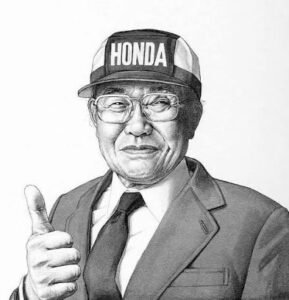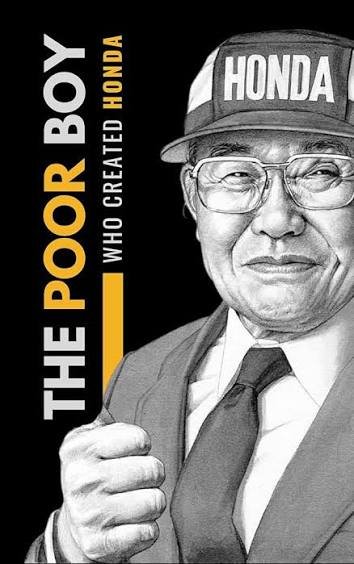🏍️ Soichiro Honda: The Inspiring Journey From a Poor Blacksmith’s Son to a Global Automotive Icon.

Soichiro Honda transformed from a blacksmith’s son into a global automotive icon through relentless innovation, perseverance, and a passion for engines.
Starting as an apprentice mechanic, he later founded his own companies, initially focusing on piston rings for Toyota and then, after surviving WWII’s destruction, created motorized bicycles to provide post-war Japan with affordable transport. This led to the founding of Honda Motor Co. in 1948, which grew from motorcycles to automobiles and Formula One racing, becoming a global powerhouse through a focus on practical engineering and a human-centered design philosophy.
Soichiro Honda’s life is one of the most extraordinary entrepreneurial stories in the world of automobiles. Born on November 17, 1906, in a remote village in Shizuoka, Japan, Honda came from a humble background. His father was a blacksmith and small-town bicycle repairman, and young Soichiro grew up surrounded by tools, iron, and machines. Although he had no formal education or engineering degree, he carried a deep fascination for mechanics—a passion that would eventually reshape the global automotive industry.
🌱 Early Life: Curiosity Sparks Innovation
As a child, Soichiro Honda was captivated by anything that moved—bicycles, engines, steam-powered vehicles. He often skipped school to watch mechanics work. Instead of textbooks, he learned by observing, experimenting, and building. This curiosity laid the foundation for the Honda engineering philosophy: simplicity, innovation, and efficiency.
Private Equity in India: A Complete Guide for Entrepreneurs
🏭 The First Venture: Tōkai Seiki (1937)
In 1937, guided by a dream bigger than his resources, Honda founded Tōkai Seiki, a company that manufactured piston rings. After early failures, he secured a major contract with Toyota, marking his entry into Japan’s fast-growing automotive sector.
But fate struck a blow , World War II bombings destroyed his factories, and a massive earthquake finished the rest. Instead of giving up, Honda famously said:
“Success is 99% failure.”
He sold the remaining assets of Tōkai Seiki to Toyota for ¥450,000, using the money to start again.
🔧 Rebirth: Honda Technical Research Institute (1946)
With post-war Japan facing fuel shortages and mobility issues, Honda spotted an opportunity. In 1946, he created the Honda Technical Research Institute, converting surplus radio-generator engines into motorized bicycles.
These simple, affordable bikes became incredibly popular among everyday workers.
🚴 Honda Motor Co., Ltd. (1948): The Beginning of a Legend
In 1948, Soichiro Honda officially founded Honda Motor Co., Ltd. along with partner Takeo Fujisawa. With a perfect blend of engineering brilliance and business strategy, Honda motorcycles quickly gained a reputation for:
durability
fuel efficiency
value for money
innovative design
By 1959, Honda entered the U.S. motorcycle market, surprising competitors with the legendary “You meet the nicest people on a Honda” campaign. This transformed motorcycles from rough biker machines into mainstream commuting vehicles.
🌍 Global Breakthrough: World’s Largest Motorcycle Manufacturer (1965)
By 1965, Honda’s global turnover crossed $77 million, and the company officially became the world’s largest motorcycle manufacturer a title it still holds today.
Honda then expanded into:
automobiles
power equipment
marine engines
robotics
aviation (HondaJet ✈️)
electric mobility
Our client looking for investment / acquisition in Logistic Sector :
🚗 Honda in the Modern Era: A Global Automotive Powerhouse
Fast forward to today, and Honda is a technological powerhouse recognized worldwide for reliability, innovation, and sustainability.
In 2024:
Revenue: ¥22 trillion (~$150 billion)
Net Profit: ¥1.1 trillion (~$7.6 billion)
Global Leadership:
Largest motorcycle manufacturer
Largest internal combustion engine maker
A top global automaker with legendary models like Civic, Accord, CR-V, City, and Activa
Honda continues to invest in electric vehicles, AI mobility, hybrid engines, robotics, and even space technologies, staying true to Soichiro’s spirit of innovation.
💡 Key Life Lesson from Soichiro Honda
Soichiro Honda proved that:
You don’t need formal education to innovate
You don’t need big capital to begin
Your background does not determine your future
Persistence, creativity, and belief in your ideas can build a global empire
His inspiring journey from a village garage to a worldwide automotive legacy is a testament to human spirit and entrepreneurial courage.
Team: Credit Money Finance

